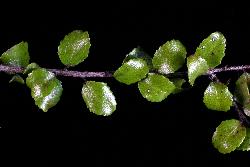- Taxon
- Gallery
- ≡ Brossaea antipoda (G.Forst.) Kuntze (1839)
- = Gaultheria erecta Banks & Sol. MSS. et Ic. nom. inval.
- = Gaultheria fluviatilis A.Cunn., Ann. Nat. Hist. 1 (1838)
- ≡ Gaultheria antipoda var. fluviatilis (A.Cunn.) Hook.f., Bot. Antarct. Voy. II (Fl. Nov.-Zel.) Part II, 161 (1854)
- = Gaultheria epiphyta Colenso, Trans. & Proc. New Zealand Inst. 22: 474 (1889 [1890])
- = Gaultheria antipoda var. erecta Cheeseman, Man. New Zealand Fl., ed. 2, 689 (1925)
Erect or rather spreading shrub, usually 0.5–2 m high; branchlets densely to rather sparsely setose, often puberulent also. Lvs alternate; petioles slender, to c. 2 mm long. Lamina (5)–7–10–(20) × (3)–6–10–(20) mm, broadly elliptic-oblong or elliptic to orbicular, coriaceous, glabrous or nearly so; margins ± undulate, crenulate-denticulate to serrate; base cuneate to rounded; apex rounded, mucronulate, sometimes ± acute. Fls solitary, axillary, but uppermost lvs sometimes so reduced that fls appear racemosely arranged; pedicels glabrate to densely hairy; bracteoles 0.7–1.5 mm long, broadly ovate. Calyx lobes 1.5–2.5 mm long, ovate-triangular, subacute to acute. Corolla ± urceolate; tube 1.5–2.5 mm long; lobes triangular. Fr. 4–6 mm diam.; calyx ± fleshy, white to red or purplish.
[From: Webb et al. (1988) Flora of New Zealand. Volume 4.]
Flowering: Nov.–Feb.




